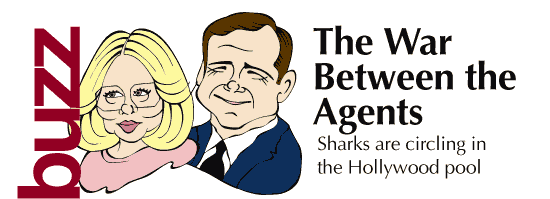

Agent-client negotiations are handled more subtly nowadays, but Mengers-style tactics are once again surfacing in Hollywood, where the leading agencies are involved in a bitter feeding frenzy for the rights to represent the film industry's leading money-earners.
 In the past year, the business has been thrown into turmoil because many
of Hollywood's biggest stars and most powerful agents have abruptly
changed agencies, lured by the promise of better roles and more money.
In the past year, the business has been thrown into turmoil because many
of Hollywood's biggest stars and most powerful agents have abruptly
changed agencies, lured by the promise of better roles and more money.With stars and directors commanding millions of dollars a picture, plus a hefty percentage of the gross, the stakes are high and poaching is rampant.
"We're seeing the same thing over again," says entertainment consultant and industry observer Ron Krueger. "Agents are poaching other agents' clients and there's a lot of bad feeling. It's like a merry-go-round. Unless you're at the very top of the tree, it's not much fun being an agent in Hollywood these days."
Since the earliest days of Hollywood, agents have been the manipulators and power-wielders behind the studios' thrones. Mostly unknown to anyone outside the film industry, they have thrived as wheeler-dealers who guide clients' careers, negotiate salaries and, nowadays, arrange those all important 'back-end deals' - percentages of a film's gross profits.
If studio executives want a Tom Cruise or a Harrison Ford to star in their next project, they have to deal with the star's agent, who, for his efforts, collects 10 per cent of his client's earnings.
The oldest, biggest and, until a few years ago, most powerful agency was the one founded 102 years ago by William Morris, which built its name by representing such legends as Charlie Chaplin, Mae West and Al Jolson.
It went on to claim such clients as Marilyn Monroe, Elvis Presley, Sammy Davis Jr. and Frank Sinatra. In the late 1970s and early 1980s, it ruled supreme with clients such as Tom Hanks, Kevin Costner, Julia Roberts and Barbra Streisand.
Even its mail room was a breeding ground for talent, spawning such industry luminaries as entertainment moguls David Geffen, Barry Diller and Michael Ovitz.
Once the most hidebound and conservative of the Hollywood agencies, its golf-and-cigar club atmosphere and gentlemanly tactics prompted the old line: "I don't have an agent; I'm with the Morris office."
 Now, however, the agency has become the shark in the Hollywood pool by
declaring war on the other agencies and startling the industry with its
aggressive tactics and blatant wooing of rivals' employees and clients.
Now, however, the agency has become the shark in the Hollywood pool by
declaring war on the other agencies and startling the industry with its
aggressive tactics and blatant wooing of rivals' employees and clients.The man responsible for the newfound combativeness is 53-year-old Jim Wiatt, who was hired from the rival International Creative Management agency last August with the mandate of revamping the Morris agency and restoring it to its former position as the most powerful and influential agency in the film industry.
Wiatt got off to a good start by bringing with him 25 of his ICM clients, including Eddie Murphy, Sylvester Stallone, Tim Allen and directors Nora Ephron, Renny Harlin, Richard Donner and Penny Marshall.
Although his move and the clients' defection infuriated Wiatt's former partners at ICM, he then set about adding to the Morris client list by recruiting ICM agents who brought their own clients with them, including Meg Ryan, Sigourney Weaver, Russell Crowe, Catherine Zeta-Jones, Emily Watson and Spike Lee. Wiatt himself lured Michael Douglas across from Creative Artists Agency.
While expanding the William Morris Agency's talent base in Los Angeles, Jim Wiatt has also ruthlessly been trimming staff in New York and London.
This has led to the departure of nearly 20 agents and some important clients, including George Clooney, Brendan Fraser, Gillian Anderson, Matthew Perry, Joseph Fiennes and the British directors Anthony Minghella and John Madden, most of whom joined CAA.
Many see the defections to William Morris as the agency's long-delayed revenge for the events of 1986 when, following the death of its veteran talent agent Stan Kamen, Michael Ovitz launched his notorious raid, poaching some of the Morris organization's biggest clients and agents, including, eventually, Roberts, Hanks and Costner.
 Observers say the same thing is now happening again, with the Morris
agency setting its sights on its two bigger rivals, CAA and I.C.M.,
forcing agents to guard their clients even more jealously than before, to
the detriment of business.
Observers say the same thing is now happening again, with the Morris
agency setting its sights on its two bigger rivals, CAA and I.C.M.,
forcing agents to guard their clients even more jealously than before, to
the detriment of business."How is it to be an agent now?" asked longtime agent Marty Bauer recently. "You come home to the love of your life with a bottle of champagne and flowers. You run a bath, do your whole seduction act. And the next morning your three best friends call her and say, 'You'd be better off with me.' That's the life of an agent."
Now agents' careers have become even more perilous because of the threat posed by the growing number of A-list stars opting not to have agents at all.
Kevin Costner and Sharon Stone use their lawyers to close deals, while Leonardo DiCaprio and martial arts star Jackie Chan are represented solely by their managers.
It is the ubiquitous Michael Ovitz, now a manager himself with DiCaprio and Cameron Diaz among his clients, who is getting the blame for the current situation.
In his latest coup, Ovitz has just persuaded author Tom Clancy to leave the William Morris Agency, which has represented him since his first book, The Hunt for Red October, and instead entrust his career to Ovitz's Artist Management Group.
Sue Mengers, who retired from William Morris a decade ago, now lives a semi-reclusive life in her mock-Georgian home in Beverly Hills. But older Hollywood hands would like to see her back in the fray.
"She'd thrive in this situation," says Krueger. "When it came to bagging big clients, Sue was the best there ever was."
- John Hiscock